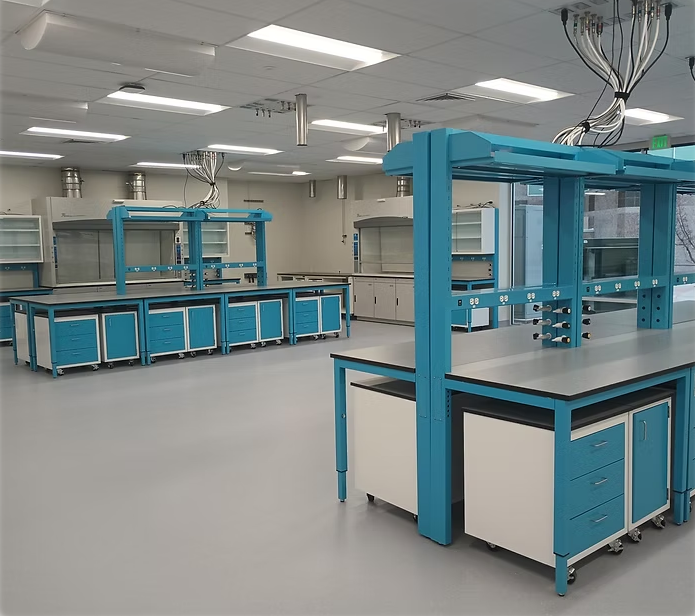Benefits of the FlexBench System in Modern Labs
Today, laboratories demand more than fixed, traditional furniture. As scientific environments become increasingly dynamic and multifaceted, there’s a growing need for modular workstations that can adapt to changing workflows. The FlexBench System has emerged as a leading solution to address this need, combining functionality, flexibility, and durability. This blog explores the advantages of this system and how it supports the evolving nature of laboratory operations.
Why Flexibility Matters in Modern Laboratory Settings
Modern laboratories face constant shifts in research direction, project timelines, and team structures. Unlike the static layouts of the past, today’s labs must be adaptable. Flexible laboratory furniture plays a crucial role in maintaining productivity and ensuring that facilities remain usable even as internal demands evolve.
One of the main constraints of traditional lab furniture is its immovability. Once installed, conventional benches often cannot be modified without considerable cost or time. This rigid approach doesn’t suit fast-paced environments where teams might need to rearrange workspaces quickly to accommodate new instruments, larger teams, or altered testing procedures.
Key Features and Design Benefits
The FlexBench System is engineered to provide a modular setup that supports a wide range of lab functions. Its components are designed for easy assembly, movement, and rearrangement, which proves invaluable in both research and educational laboratories. Below are some standout features that contribute to its appeal:
- Modular Design: Each unit can function independently or as part of a larger configuration. Whether you need a solo workstation or a collaborative island, the system can be adjusted accordingly.
- Integrated Utility Channels: Many configurations include built-in channels for power, gas, data, and water, reducing clutter and ensuring a safer workspace. This integration helps meet the utility requirements of diverse lab activities without relying on external structures.
- Durable Construction: Built with lab-grade materials, the system is resistant to chemical exposure, spills, and impact. This ensures long-term usability even in harsh working conditions.
- Height Adjustability: Some models offer manual or electronic height adjustments, accommodating different user preferences and making the workstations ergonomically sound.
- Storage Integration: Cabinets, drawers, and shelving can be added as needed. This customization keeps materials within reach and improves task efficiency.
The system is ideal for various applications, from analytical chemistry and microbiology to electronics and engineering labs, making it a truly versatile option.
Enhancing Efficiency and Workflow
In any laboratory, efficiency is more than a convenience, it’s a necessity. Delays or disruptions due to inadequate workstations can slow down experiments, increase the risk of error, and affect overall output. The FlexBench System addresses this by improving the flow of both people and processes.
One of the key advantages is how quickly it can be adapted to meet current needs. For instance, if a new piece of equipment is introduced, the bench can be rearranged to accommodate its footprint. If a team grows, workstations can be expanded or redistributed without affecting the entire lab layout.
Long-Term Cost and Space Efficiency
While initial investments in modular furniture might be higher than basic setups, the long-term cost savings are substantial. One of the primary reasons is the reduced need for structural modifications during lab upgrades or redesigns. Traditional lab furniture often requires costly removal and replacement when a lab’s focus changes. The FlexBench System, however, is designed for repeated reconfiguration without losing integrity or performance.
Space efficiency is another significant benefit. The system can be adjusted to maximize the available area, allowing more people or equipment to be accommodated within the same footprint. This is especially important for urban laboratories or institutions where space is at a premium.
Supporting Collaborative and Individual Work
The work environment in laboratories is changing. There is now a stronger emphasis on collaboration, project-based work, and multi-disciplinary teams. At the same time, many tasks still require focused, individual effort. The FlexBench System provides the adaptability to support both collaborative and individual modes of work.
Teams can easily create shared workspaces for group experiments or analysis and then reconfigure the layout to support solo work when required. The availability of optional dividers, variable bench sizes, and movable components allows for a tailored environment, whether you are conducting detailed measurements or working on a group project.
Final Thoughts
Laboratory design directly impacts the efficiency, safety, and adaptability of scientific work. As labs become more multi-functional and technology-driven, outdated and rigid furniture systems are quickly becoming obsolete. The FlexBench System stands out as a forward-thinking solution designed to support the changing needs of research and education environments.
Its flexible design, ergonomic features, integrated utilities, and modular structure allow laboratories to optimize space, reduce costs, and maintain high productivity. Choosing this system is a smart investment in future-ready infrastructure that meets the evolving standards of modern science. Whether starting a new lab or upgrading an old one, the FlexBench System offers a solid foundation for efficient and adaptable lab performance.

